Communications chips maker Qorvo (NASDAQ: QRVO) reported results ahead of analysts' expectations in Q1 CY2024, with revenue up 48.7% year on year to $941 million. On the other hand, next quarter's revenue guidance of $850 million was less impressive, coming in 8% below analysts' estimates. It made a non-GAAP profit of $1.39 per share, improving from its profit of $0.26 per share in the same quarter last year.
Qorvo (QRVO) Q1 CY2024 Highlights:
- Revenue: $941 million vs analyst estimates of $926.4 million (1.6% beat)
- EPS (non-GAAP): $1.39 vs analyst estimates of $1.22 (14.1% beat)
- Revenue Guidance for Q2 CY2024 is $850 million at the midpoint, below analyst estimates of $923.9 million
- Gross Margin (GAAP): 40.6%, up from 24.9% in the same quarter last year
- Inventory Days Outstanding: 116, up from 96 in the previous quarter
- Free Cash Flow of $169.6 million, down 63.6% from the previous quarter
- Market Capitalization: $11.28 billion
Formed by the merger of TriQuint and RF Micro Devices, Qorvo (NASDAQ: QRVO) is a designer and manufacturer of RF chips used in almost all smartphones globally, along with a variety of chips used in networking equipment and infrastructure.
Qorvo’s peers and competitors include Broadcom (NASDAQ:AVGO), Cirrus Logic (NASDAQ:CRUS), MACOM Technology (NASDAQ:MTSI), Qorvo (NASDAQ:QRVO), Qualcomm (NASDAQ:QCOM), Skyworks (NASDAQ:SWKS) and Texas Instruments (NASDAQ:TXN).Processors and Graphics Chips
Chips need to keep getting smaller in order to advance on Moore’s law, and that is proving increasingly more complicated and expensive to achieve with time. That has caused most digital chip makers to become “fabless” designers, rather than manufacturers, instead relying on contracted foundries like TSMC to manufacture their designs. This has benefitted the digital chip makers’ free cash flow margins, as exiting the manufacturing business has removed large cash expenses from their business models.
Sales Growth
Qorvo's revenue growth over the last three years has been unimpressive, averaging 2.3% annually. But as you can see below, this was a strong quarter for the company, with revenue growing from $632.7 million in the same quarter last year to $941 million. Semiconductors are a cyclical industry, and long-term investors should be prepared for periods of high growth followed by periods of revenue contractions (which can sometimes offer opportune times to buy).
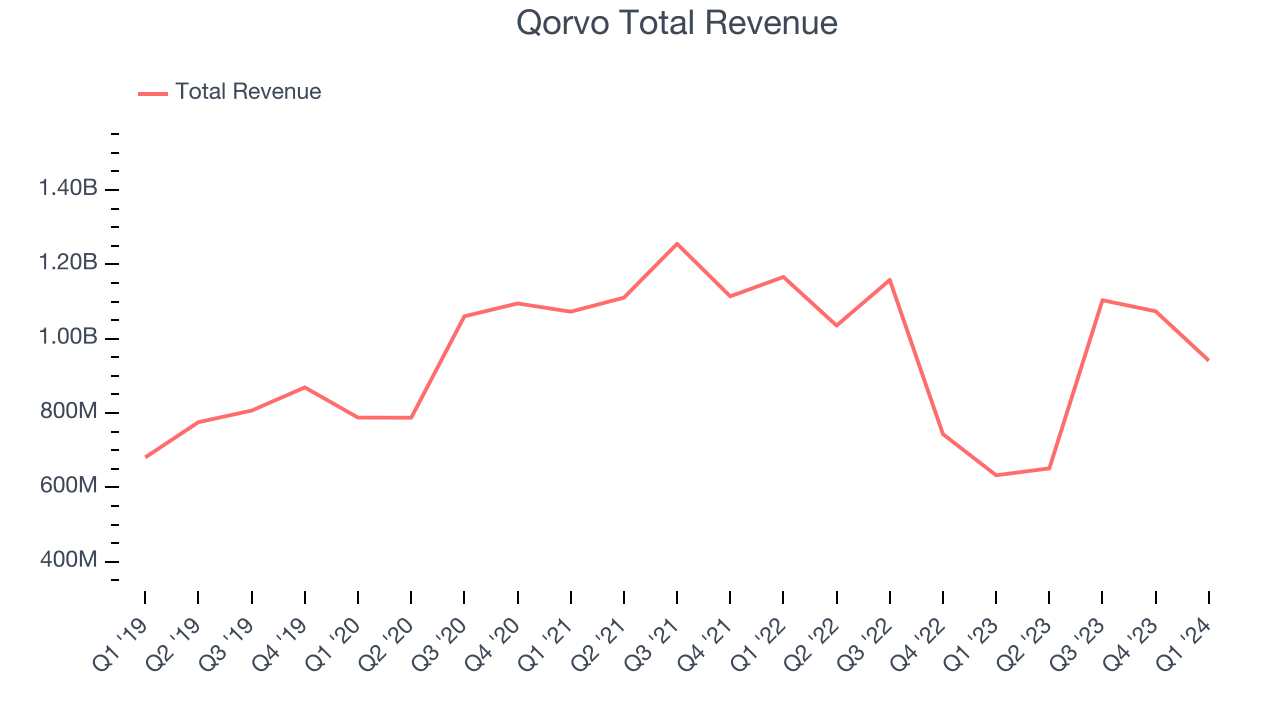
Qorvo had a great quarter as its 48.7% year-on-year revenue growth exceeded analysts' estimates by 1.6%. We believe the company is still in the early days of an upcycle, as this was just the second consecutive quarter of growth and a typical upcycle tends to last 8-10 quarters.
Qorvo's management team believes its revenue growth will continue, guiding to 30.5% year-on-year growth next quarter. Analysts expect the company to grow its revenue by 12.2% over the next 12 months.
Product Demand & Outstanding Inventory
Days Inventory Outstanding (DIO) is an important metric for chipmakers, as it reflects a business' capital intensity and the cyclical nature of semiconductor supply and demand. In a tight supply environment, inventories tend to be stable, allowing chipmakers to exert pricing power. Steadily increasing DIO can be a warning sign that demand is weak, and if inventories continue to rise, the company may have to downsize production.
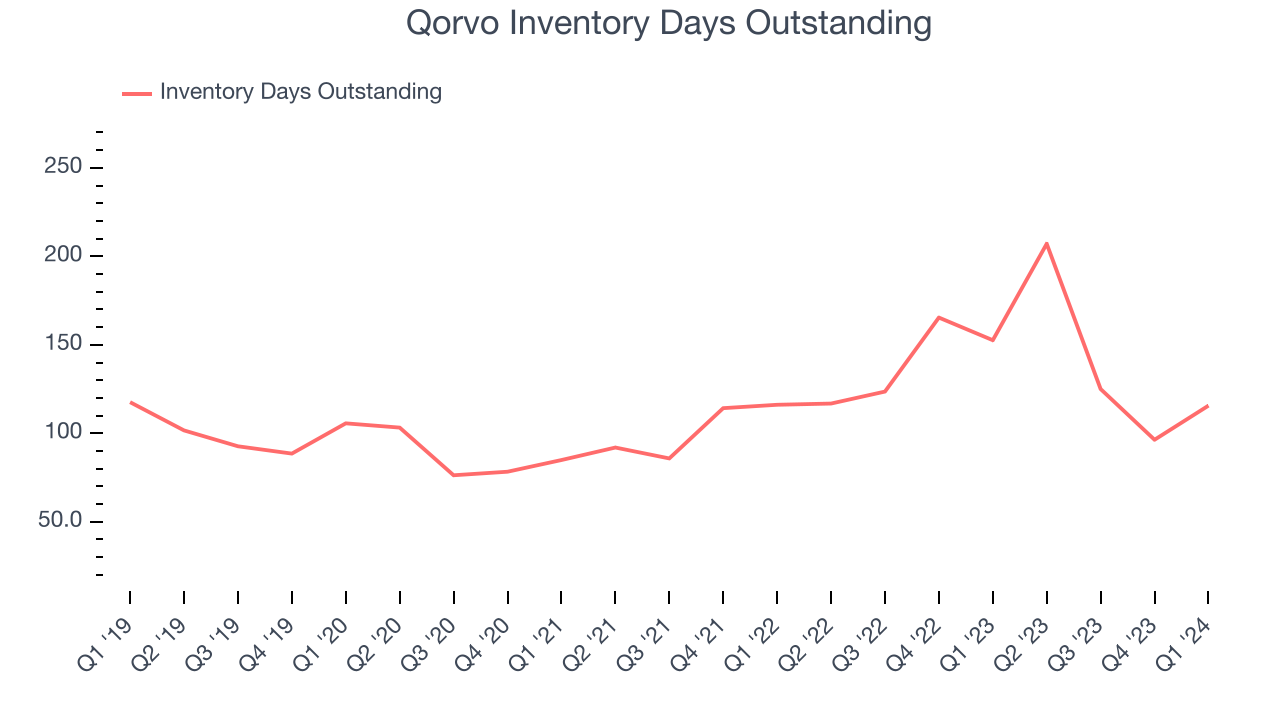
This quarter, Qorvo's DIO came in at 116, which is 4 days above its five-year average, suggesting that the company's inventory has grown to higher levels than we've seen in the past.
Pricing Power
In the semiconductor industry, a company's gross profit margin is a critical metric to track because it sheds light on its pricing power, complexity of products, and ability to procure raw materials, equipment, and labor. Qorvo's gross profit margin, which shows how much money the company gets to keep after paying key materials, input, and manufacturing costs, came in at 40.6% in Q1, up 15.7 percentage points year on year.
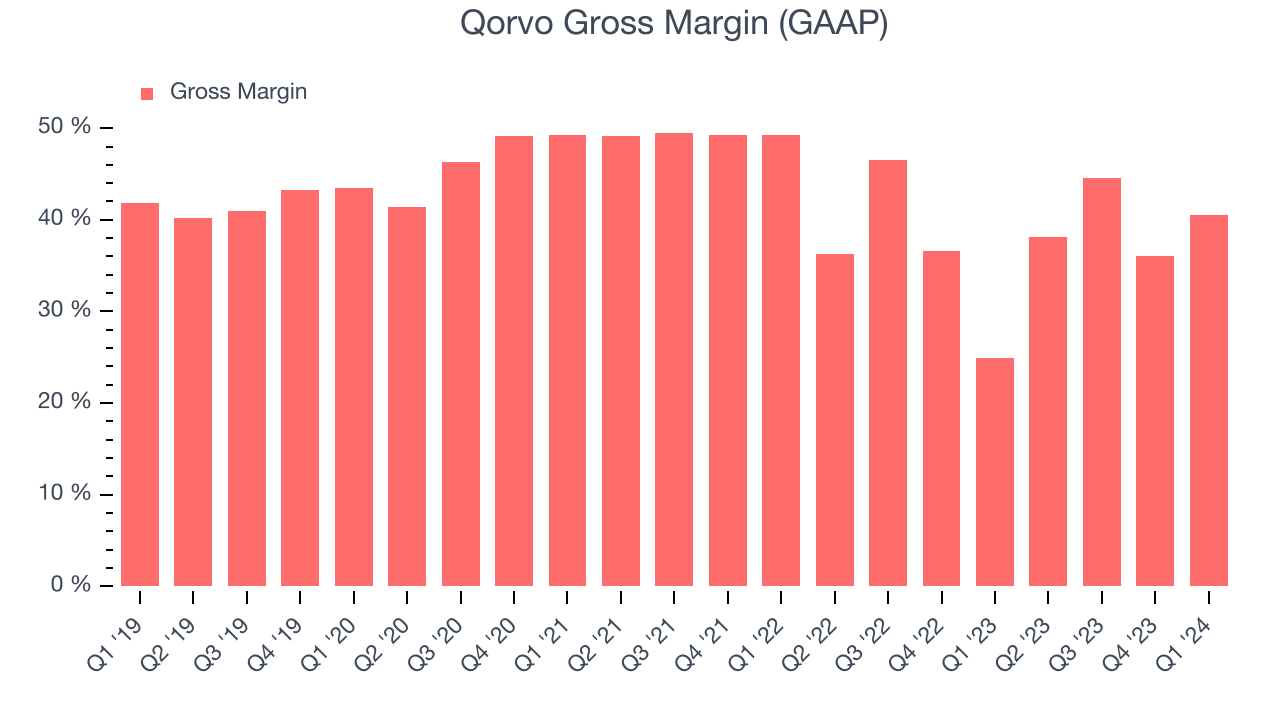
Qorvo's gross margins have been trending up over the last 12 months, averaging 40%. This is a welcome development, as Qorvo's margins are below the industry average, and rising margins could suggest improved demand and pricing power.
Profitability
Qorvo reported an operating margin of 15.6% in Q1, up 10.3 percentage points year on year. Operating margins are one of the best measures of profitability because they tell us how much money a company takes home after manufacturing its products, marketing and selling them, and, importantly, keeping them relevant through research and development.
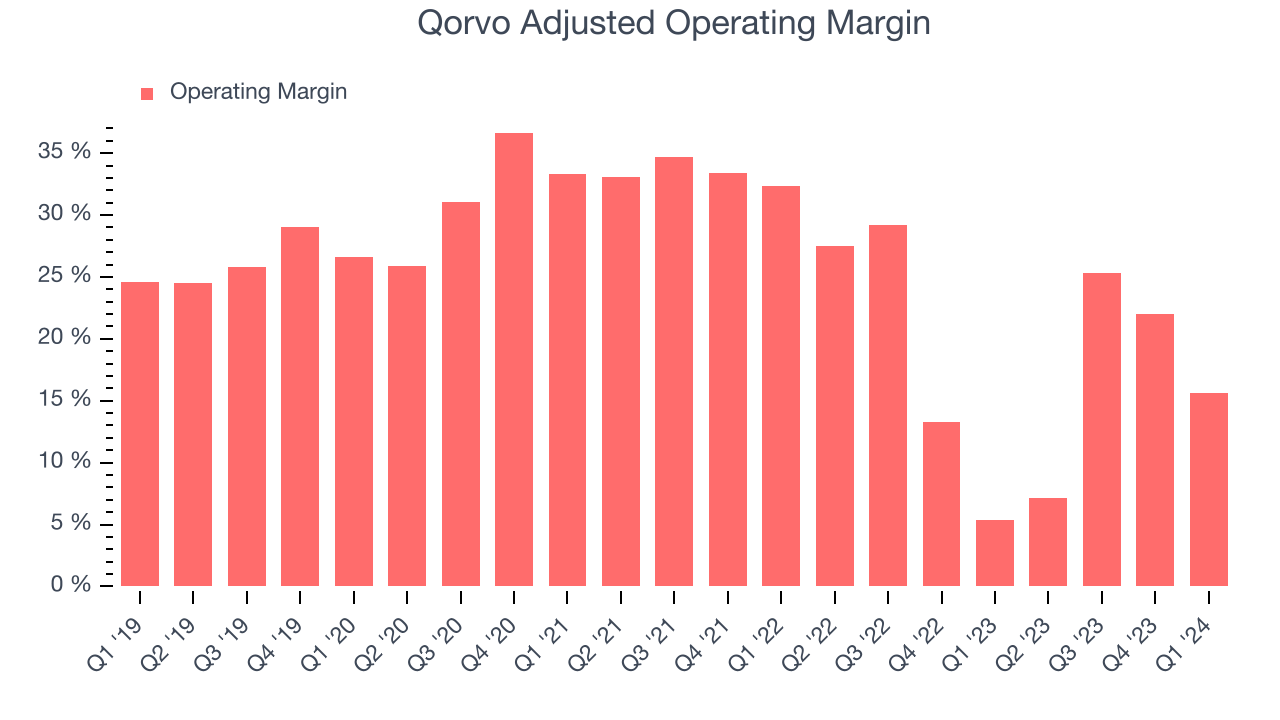
Qorvo's operating margins have been trending up from the last year, averaging 18.8%. This is a welcome development for Qorvo, whose cost structure isn't as efficient as it could be, as indicated by its slightly below-average margins.
Earnings, Cash & Competitive Moat
Analysts covering Qorvo expect earnings per share to grow 78.8% over the next 12 months, although estimates will likely change after earnings.
Although earnings are important, we believe cash is king because you can't use accounting profits to pay the bills. Qorvo's free cash flow came in at $169.6 million in Q1, up 441% year on year.
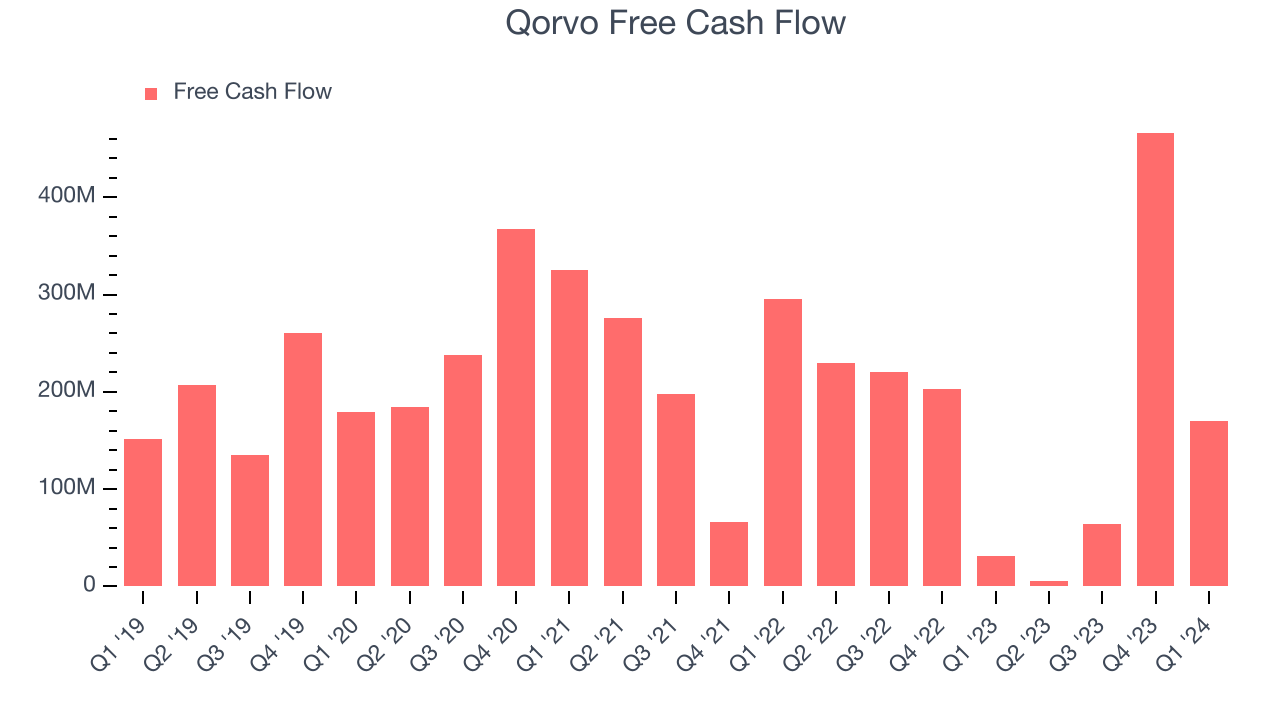
As you can see above, Qorvo produced $705.9 million in free cash flow over the last 12 months, a solid 18.7% of revenue. This FCF margin is above average for semiconductor companies and should put Qorvo in a relatively strong position to invest in future growth initiatives.
Return on Invested Capital (ROIC)
EPS and free cash flow tell us whether a company was profitable while growing revenue. But was it capital-efficient? Enter ROIC, a metric showing how much operating profit a company generates relative to how much money the business raised (debt and equity).
Qorvo's five-year average ROIC was 9.4%, somewhat low compared to the best semiconductor companies that consistently pump out 35%+. Its returns suggest it historically did a subpar job investing in profitable business initiatives.
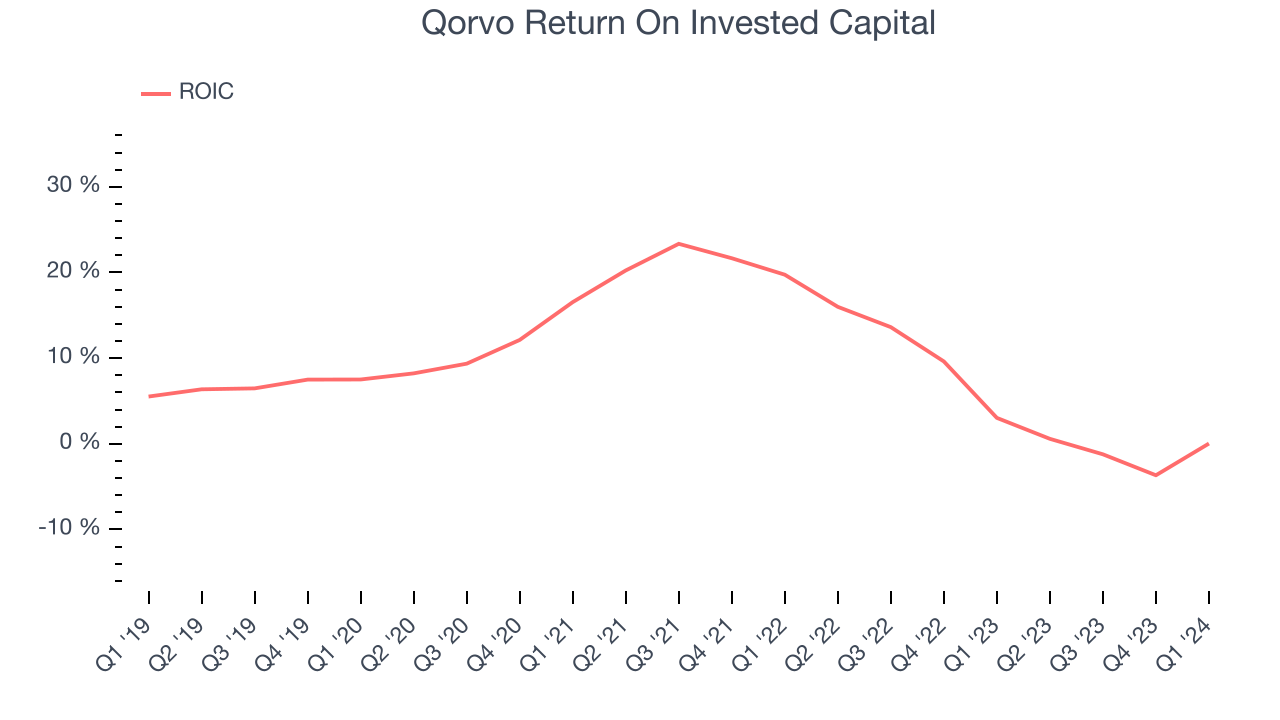
The trend in its ROIC, however, is often what surprises the market and drives the stock price. Unfortunately, Qorvo's ROIC averaged 10.5 percentage point decreases over the last few years. Paired with its already low returns, these declines suggest the company's profitable business opportunities are few and far between.
Balance Sheet Risk
As long-term investors, the risk we care most about is the permanent loss of capital. This can happen when a company goes bankrupt or raises money from a disadvantaged position and is separate from short-term stock price volatility, which we are much less bothered by.
Key Takeaways from Qorvo's Q1 Results
We were impressed by Qorvo's strong gross margin improvement this quarter. We were also excited its EPS outperformed Wall Street's estimates. On the other hand, its revenue guidance for next quarter missed analysts' expectations and its inventory levels increased. Overall, this quarter's results were mixed. Investors were likely expecting more, and the stock is down 10.6% after reporting, trading at $100.03 per share.
Is Now The Time?
When considering an investment in Qorvo, investors should take into account its valuation and business qualities as well as what's happened in the latest quarter.
We cheer for everyone who's making the lives of others easier through technology, but in the case of Qorvo, we'll be cheering from the sidelines. Its revenue growth has been weak over the last three years, but at least growth is expected to increase in the short term. And while its solid free cash flow generation gives it re-investment options, the downside is its relatively low ROIC suggests it has struggled to grow profits historically. On top of that, its gross margins are weaker than its semiconductor peers we look at.
Qorvo's price-to-earnings ratio based on the next 12 months is 14.6x. While there are some things to like about Qorvo and its valuation is reasonable, we think there are better opportunities elsewhere in the market right now.
Wall Street analysts covering the company had a one-year price target of $115.80 per share right before these results (compared to the current share price of $100.03).
To get the best start with StockStory check out our most recent Stock picks, and then sign up to our earnings alerts by adding companies to your watchlist here. We typically have the quarterly earnings results analyzed within seconds of the data being released, and especially for the companies reporting pre-market, this often gives investors the chance to react to the results before the market has fully absorbed the information.
